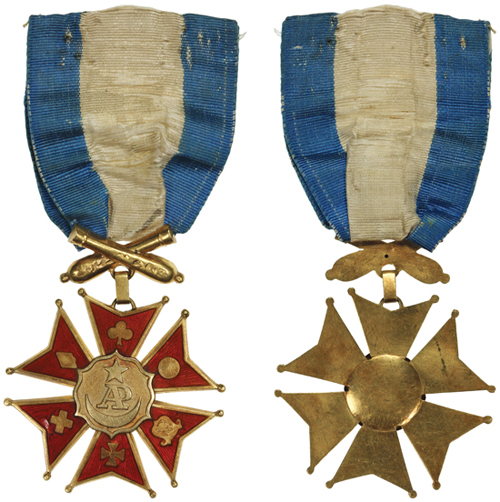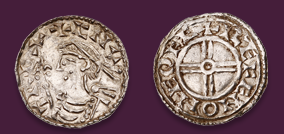
Auction: 314 - Numismatic Collector's Series Sale
Lot: 1073
ND (ca. 1869) Military Society of the Army of the Potomac Badge of Pride. 6.54gms - gold, enamel and ribbon. 36mm across/34mm high/3mm thick. By: Unknown maker - likely a New York firm. Design: AP monogram at center (Army of the Potomac), star (emblem of 12th corps) above, crescent (emblem of the 11th corps) below, six pointed star radiating from center, each with further emblem corps symbol in gold surround by red enamel; crossed cannons (symbolizing artillery batteries that supported the Army of Potomac) affixed between pendant and ribbon; silk ribbon at top with 16mm white inner band and 9mm outer blue bands; (missing) crossed swords (representing the calvary that was a separate corps within the Army of the Potomac) at top of ribbon.The Army of the Potomac, created in 1861, was the major Union Army in the Eastern Theater during the Civil War. Major battles participated in by this army include the First Bull Run, Fredericksburg, Gettysburg and Appomattox.After the war had ended, the popularity of veterans´ organization was undeniable - and from that popularity sprang the Military Society of the Army of the Potomac (SAOP). Founded in New York on July 5th 1869, the society was formed by Philip H. Sheridan who would also serve as its first President. Stipulations for inclusion in this exclusive society were twofold - all members must have served as former officers in the Army of the Potomac and the applicants must have had prior service in any unit of any campaign in which the Army of the Potomac participated. Society goals were numerous, but its primary focus was to keep the memory of battle alive, promote veteran welfare and to maintain relationships.The elite nature of the SOAP would attract many notables as members. Included were Major-General George B. McClellan and Major-General George Gordon Meade. As a friend of General Sheridans, Custer was a natural fit for this society. Of the 72 engagements between April 27, 1863 and April 9, 1865, Custer was there for many of them. In his own word, "It was my fortune - I may term it my good fortune - to have been associated with the Army of the Potomac under its various commanders, from the date of its organization to that of its disbandment. From Bull Run to Appomattox I participated in all the battles except that of Frederickburg, and in most of the important minor engagements and skirmishes....I served on the staffs of General Kearny, (Baldy) Smith, Sumner, McClellan, and Pleasonton...and,...we of the Army of the Potomac, ever proud of the record of that army, will guard with jealous care the history of its fame...Further solidifying Custer´s appreciation for the memory of the Army of the Potomac, a formal picture taken just prior to Little Big Horn illustrates Custer in uniform wearing only his Society of the Army of the Potomac Badge.Condition-wise, the present badge, more-so than some of the others displays what one might consider typical wear. A small enamel chip is noted on one of the rays and several cracks are also visible with magnification - none being of great significance. The ribbon is aged with slight yellowing to the white silk with some central fraying. As mentioned in the item detailing above, the crossing swords that would have been originally issued to aid suspension from an outfit are now missing.While badges from the SAOP weren´t issued with engravings that indentify the recipient, thus making absolute indentification difficult, we have every reason to believe from the accompanying archive, that the present is in fact George Custer´s personal badge. While post-war it remains extremely significant as a result of Custer´s personal affection for the group as well as the restrictive terms of entrance into the society that would have limited an adundance of similar badges. As such, yet another item of immense historical importance.
Sold for
$25,000




